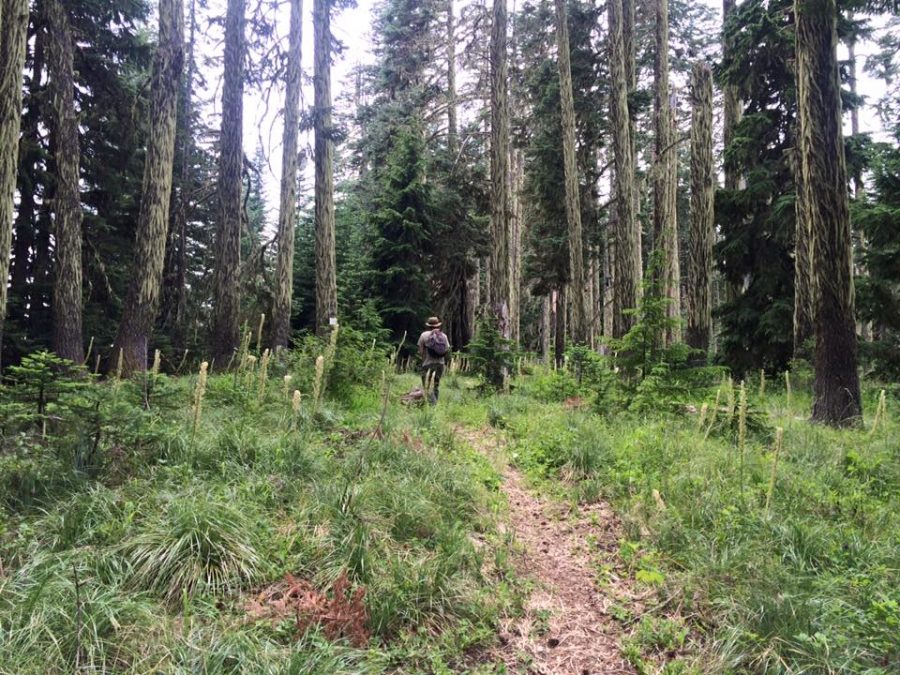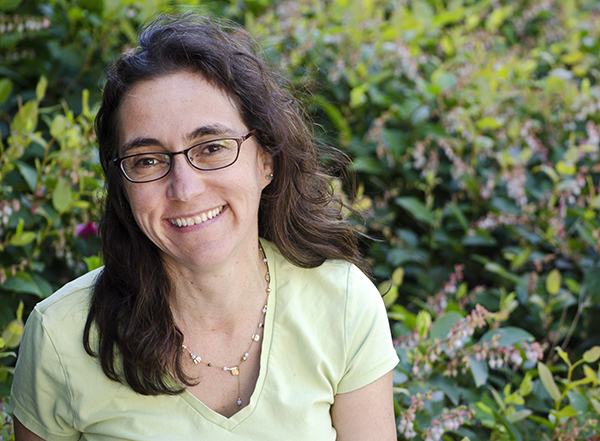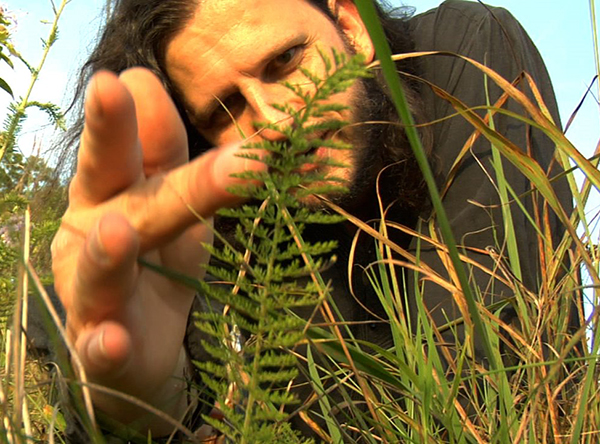By Kurt Beil, ND, LAc, MPH
Everyone understands how time spent in a beautiful natural setting can be good for you. The peace and relaxation from the surrounding trees and other vegetation leaves one feeling restored and invigorated. These experiences have been sought for hundreds of years, and this simple activity is affordable and enjoyable for anyone.
However the practice of Forest Bathing, originating in Japan as shinrin-yoku, is more involved than just a simple “walk in the woods.” Forest bathing is a fully focused body-mind event incorporating the use of all five senses and interaction with the surrounding landscape. It is part nature walk, part moving meditation and part quiet contemplative experience of immersing oneself in the healing presence of the forest.
There has been an astounding amount of supportive research demonstrating forest bathing’s significant benefits to physical and mental health.1,2 This article explores some of the background information about this modern practice with ancient roots and discusses some of the evidence and mechanisms for why it is such a beloved and effective health-promoting experience.
Forest bathing background
Forest bathing is based on an ancient Japanese cultural respect and reverence for the natural world and the interactions with the landscape that occur as a result. Shinrin-yoku (lit. “Immersion in the Forest Air”) is an experience that lets people be mindfully present with the surrounding forest. The sights, sounds and smells of the environment support and comfort each person as they literally “bathe” in the forest air. Walking with the direct purpose of connecting with the vegetation around you is a very powerful way of engaging the senses and stepping away from the concerns and distractions of modern life.
Though it has ancient origins, shinrin-yoku did not begin as a distinct practice until the early 1980s when it was promoted by the Japanese National Ministry of Forestry in an effort to get people to utilize public lands more frequently.3 In an era when the modern pressures of urbanization, academic and job stress, and television were decreasing the amount of time people spent enjoying the out-of-doors, efforts were made to get people out and enjoying their surrounding environments, and shinrin-yoku was born. Dr. Alan Logan, ND, co-author of “Your Brain on Nature” and one of the few Westerners to have spent time studying the shinrin-yoku model in Japan, has noted how complete the Japanese thinking about the problem is.4 He notes that forest bathing was promoted to address the “diseases of civilization:” sedentary lifestyle, over-exposure to digital media, feelings of isolation and disconnection, and lack of community.3 Developing a culturally relevant, healthy, nature-based activity that could be enjoyed alone or in groups was, and still is, the perfect way to address many individual and public health issues.
Knowing that forest bathing could be an experience with potential health benefits, Japanese scientists began to study its effects. As the evidence about shinrin-yoku’s positive health effects began to accumulate, it gained support from various parts of Japanese society. The evidence is now so strong that forest bathing is a recognized health intervention in Japan, with special land designated and jointly funded by the Japanese National Ministries of Forestry and Health as Forest Therapy Bases. Currently there are 62 of these dedicated centers, akin to US National Parks, that provide forest bathing experiences to locals and visitors. These parks have signage explaining the health benefits of various landscape components, and have on-site physicians and health experts who provide personalized recommendations according to individuals’ health status. Organizations such as the Japanese Forest Therapy Society coordinate and report on the continuing research being conducted.5 There are a number of different avenues of exploration that all integrate into one holistic, health-promoting experience.
Bio-evolutionary origins
Many of the health benefits of forest bathing can be explained by derivations of the Biophilia Hypothesis, an idea developed by the renowned biologist and author E.O. Wilson. This theory describes biophilia as “the innate human affinity for life and other living things”6 resulting from millions of years of exposure and adaptation. For our prehistoric ancestors, the natural world was a constant experience and the background context in which all other activities occurred. Throughout millennia of exposure our ancestors evolved to respond to the natural world as a baseline of experience. The vast majority of this experience was the same as ours today: quiet, serene landscapes with natural vegetation, geological and water formations and encounters with small birds, insects and mammals. It is these types of environments to which our ancestors’ sensory-perceptual and autonomic nervous systems adapted over the millennia, and the reason why we find them comforting and relaxing today.
Of course, nature is not always peaceful. Occasional threats such as attack by a predator or a natural disaster would occasionally prompt the “fight-or-flight” (FoF) reaction. However, in natural settings the body would return to its resting state as soon as the danger passed, facilitated by the calm scenery of the natural surroundings. In contrast, our modern world is replete with stimuli that trigger our ancestral fight-or-flight response, from police sirens to watching the evening news. For many of us, these are closer to our daily experience than being in the primarily serene landscapes of our prehistoric ancestors. This is the reason why experiencing something like forest therapy can feel so relaxing: Immersion in the quiet stillness of a forest allows us a respite from the intrusions of modern living and a return to the ancestrally familiar sights and sounds and smells that match our neuro-evolutionary baseline. When we return to the forest, we return home. This manifests in a few ways that allow forest bathing to be such a valuable health-promoting experience.
Reduction of stress and allostatic load
The relaxing activity of being in a picturesque natural landscape wasn’t considered clinically useful until an American researcher named Roger Ulrich conducted a series of studies showing how stress-reducing these activities can be. Ulrich’s first study showed surgery patients could recover from faster, with less post-op pain medication and with better mood if their recovery room had a window view of the hospital’s adjacent natural area than a blank brink wall.7 One of his follow-up studies exposed participants to a stressor, measured stress recovery using both biomarker and psychometric measures while watching videos of either natural or urban environments, and assessed.8 Perhaps unsurprisingly, participants who viewed flowing forested streams had a dramatically quicker return to psychophysiological baseline then participants that viewed congested traffic. These conceptually simple studies showed that measuring the stress-reducing effects of “nature” was possible and potentially significant, and laid the groundwork for an explosion of environmental stress research that followed.
We obviously know now that stress has significant impacts on physical and mental health.9 As noted above, much of forest bathing’s ability to reduce stress is the result of biophilic response. When we are immersed in the forest, our autonomic nervous systems respond to the stimuli of an evolutionarily baseline context that promotes a parasympathetic maintenance state. This shift is perceived as relaxing and is more health promoting than the varying level of chronic sympathetic fight-or-flight state in which many people experience their daily lives.
Medically, a more useful concept for quantifying the damage produced by stress is allostatic load, “the wear and tear that the body experiences” due adverse psycho-social and environmental conditions.10 Allostatic load allows for the measurement of cumulative negative effects of stress on the body and is typically assessed according to various biomarkers including:
- Cardiovascular measures (e.g. heart rate and blood pressure)
- Neuro-cardiac measures (e.g. heart-rate variability (HRV))
- Endocrine markers (e.g. salivary cortisol and serum insulin)
- Neuro-endocrine markers (e.g. urinary epinephrine and norepinephrine)
- Immune markers (e.g. IL-1, IL-6 and TNF- α), and
- Other metrics such as blood oxygen perfusion.
All of these biomarkers have been used in forest-bathing research to demonstrate clinically and statistically significant reductions in allostatic load and associated levels of physiologic stress, many from a single exposure as brief as 15 minutes.2,11,12
Forest bathing is also stress reducing because of the intentional way this activity is conducted. The mindful awareness of one’s surroundings is a specific component of shinrin-yoku, and this likely contributes to its rejuvenative effects. Mindfulness of any type is associated with significant health benefits and mindfulness-based walking programs have demonstrated substantial stress-reducing and health-promoting capacity.13,14
Forest bathing’s effects on affect and mood
Stress-reduction, allostatic load and mindfulness have beneficial impacts on psychological health as well as physiology status. Multiple studies have shown that spending time in forest therapy centers and other natural settings has beneficial effects on both positive and negative aspects of mood.15,16
The good feelings everyone gets from being outside on a beautiful sunny day are more than just passing perks. Forest bathing has been researched extensively for its ability to promote clinically relevant positive mood changes17–19 in both feelings of joy and happiness (hedonia) as well as the deeper experiences of meaning, purpose and connection to something larger than oneself (eudaimonia).20 According to the field of positive psychology, both of these states improve longevity, quality of life and immune system function, while decreasing risk of cardiovascular disease and mental illness.21,22 These are all important benefits of a nature-based experience and may be among the reasons that epidemiological studies show residential proximity to natural spaces is associated with reduced mortality rates, even after controlling for factors like socio-economic status and exposure to pollution.23 Being in natural settings helps us feel good, which leads to being healthier in mind and body.
Similarly, shinrin-yoku and other nature exposures have demonstrated clinical benefit in addressing negative mood states and various psychopathologies.11,18 Several studies have shown the benefits of nature-based group walking programs for individuals diagnosed with mild-to-moderate depression, as measured by the Beck Depression Inventory (BDI) and Hamilton Depression Rating Scale (HDRS), and supported by qualitative participant feedback.19,24 Another study has demonstrated significant reduction in HDRS scores after weekly group cognitive behavioral therapy (CBT) that occurred outside in a forested setting, compared to a control group CBT intervention occurring inside a local clinic.12
Evidence of improvement in mood disorders provides clinically useful support for the idea of nature-based therapies as an adjunctive component to the holistic approach of mental-health care. These studies provide supportive evidence for the potential causal mechanisms underlying longitudinal and epidemiological studies that show spatial correlation between the green-ness of a person’s residential location and a reduced prevalence of depression and mental distress, even after controlling for factors like socio-economic status.25–28 All of this information together suggests that exposure to forested areas is an important component of improving and maintaining mental health and well-being.
PTSD and the military
One group in the United States directly benefiting from forest therapy’s stress and mood effects are military veterans suffering with PTSD. The relaxing, safe environment of a forest or other natural area is the perfect setting to address the complex psycho-physiological disruptions of PTSD, and many programs are beginning to adopt this approach as an adjunctive method of treatment. One literature review for veterans with PTSD showed significant benefit of nature-based therapies on both objective and subjective measures including PTSD symptoms, psychological well-being, social functioning, quality of life and depression.29 This natural, integrative approach has been so well received that governmental and private funding sources have combined to create a designated forest therapy space known as the Green Road on two acres of the Walter Reed National Military Medical Center campus in Bethesda, Maryland.30 This space is set aside for veterans and their families to enjoy all of the benefits of a forest therapy experience. No data are available yet about the efficacy of this project, but response from the veterans and monitoring clinical staff is overwhelmingly positive.
Attention, memory and performance
Another area of mental health that forest bathing research focuses on is attention and the ways the brain processes sensory information. Brains are constantly processing and filtering all of the stimuli from the surrounding environment. The effort of this filtering process can lead to mental fatigue when it becomes overloaded, such as having to turn off the radio to concentrate on driving in the rain with your kids yelling in the back seat. Too many simultaneous stimuli can overwhelm the senses.
According to environmental psychologists Rachel and Stephen Kaplan, the same evolutionary response mentioned above allows us to process and filter stimuli of natural settings without difficulty or effort. In fact, quite the opposite occurs: According to the Kaplan’s Attention Restoration Theory (ART), the stimuli of natural settings replenish mental energy and reduce mental fatigue.31 This is the reason many people feel refreshed after taking a walk in nature to “clear their head,” and why many people take their vacations to tropical beaches or serene remote locations rather than busy urban centers.
The hypotheses of ART have been validated by many studies, from memory tasks to student and worker performance, all benefited by exposure to natural scenery in the background.32,33 Other studies in this area suggest that cumulative exposure to natural green spaces over a lifetime may be beneficial for cognitive status and help reduce age-related cognitive decline and dementia.34,35 This is in keeping with recent fMRI studies that show a lifetime of green space exposures can enhance key neuroanatomical areas of the brain relating to memory, attention and emotional control.36,37
One clinical application of the Kaplan’s ART relates to improvements in attention deficit hyperactivity disorder (ADHD). A number of studies have shown that children with ADHD have a reduction in severity of symptoms, as well as increased concentration and memory, when allowed to play or walk in an outdoor, natural area as compared to a built outdoor or indoor space.38,39 This research has positive implications for addressing ADHD and other childhood behavior disorders with simple, environmentally-based, non-pharmacological interventions. Similar research demonstrates the positive effect of natural vs. built view effects on adult impulsivity,40 which is known to be co-morbid with psychiatric disorders (anxiety and depression) and unhealthy behaviors (substance abuse, risky sex, violence against self and others.)41 It is a potentially useful and powerful tool to have such preventive health effects just by spending some time in the out-of-doors.
A beneficial olfactory experience
One of the other senses that makes forest bathing so therapeutic is the olfactory experience. Walking through the forest and smelling the rich combination of soil, flower, trees and fresh air is dramatic. It is well known that smells convey information directly to the brain and have an important influence on mood, memory and behavior.42 It is likely that the smells of the forest are a significant component of the stress-reducing and attention-restoring effects mentioned above. However, this aromatherapeutic journey is more than just psycho-neurologically beneficial.
Forest-bathing research has demonstrated that specific olfactory compounds produced by forest trees directly affect human physiology. These chemical terpenes known as phytoncides are produced by the coniferous pines, cypress and cedars that make-up Japan’s Forest Therapy Bases. Studies have demonstrated the ability of these chemicals in both lab and forest settings to positively affect blood pressure, heart-rate variability, salivary cortisol, alpha-amylase and oxygenation of the prefrontal cortex..434445 This research confirms that the benefits of shinrin-yoku come from truly becoming immersed and “bathing” in the forest air.
A specific area of interest regarding phytoncides is their ability to stimulate immune system function, in particular the innate natural killer (NK) cells that are famous for destroying tumors and viral-infected cells. The now-classic field study by Dr. Qing Li published in 2010 demonstrated that a single 3-hour forest-therapy exposure can elevate both NK cell quantity and activity for up to 30 days.46 Many other shinrin-yoku studies have replicated or added to these findings, and Dr. Li has published a book on this research.2,47 This awareness of phytoncides has led some researchers to investigate the therapeutic potential of forest bathing for providing adjunctive cancer care in semi-residential settings.48,49 The mechanism of NK cell activation may be the reason that percent of forested land in Japan is inversely correlated with mortality rates of cancer, even after controlling for smoking and socio-economic status.50
No one is advocating for forest bathing to replace current oncotherapies, but given its demonstrated immune-stimulatory actions as well as other mental/emotional and quality-of-life benefits49 it makes sense to include as a complementary component of cancer care.
Ecopsychology and sustainability
Lastly, it has been proposed that activities like forest bathing may be able to help us with the biggest health concern of all: the continued existence of viable ecosystems and preservation of life on planet Earth. Environmental degradation is recognized as a significant public health issue,51 and the Lancet’s Commission on Global Health and Climate Change has labelled that process “the biggest global health threat of the 21st century.”52 Without an sustainable environment all living things including human beings are at risk.
Forest bathing has been offered as one solution to the ecological crisis because it gets people in touch with their surrounding environment.53 In this era of increasing urbanization, longer work hours, digital distractions, and for children the “stranger danger” and “helicopter parenting” that keep kids inside, it is becoming rarer for people to spend time outside in nature.54 This creates a situation, described in 1993 by the ecologist and author Robert Pyle, as an “extinction of experience,” in which reduced immersion in nature leads to a lack of concern for it, resulting in a downward spiral of passive and active environmentally destructive behaviors, environmental degradation and ultimately loss of health to both individuals and ecosystems.55
The research clearly shows that direct, personally meaningful experiences with natural spaces are the most important factors for overcoming this extinction and for promoting a strong ethic of environmentally sustainable behaviors.33,56 Scientists in Japan are acutely aware of this separation between people and environment and of the value that nature immersion experiences can bring.3 Shinrin-yoku was created specifically to address and reduce the disconnection people felt from the natural world, and to get them outside and engaged with their surroundings. Getting people, especially children, out into natural environments like a local park or nature center is the best way to establish and maintain current and future generations’ capacity for pro-environmental actions that are going to be healthy for both them and the planet.57
Conclusion
Forest therapy is a modern application of an ancient experience. It can help us achieve a state of balance and peace within our bodies and minds. The accumulated research evidence over the past few decades has brought scientific validity and clinical applicability to this simple human practice. Interest in forest bathing is already quite high in contemporary media and the general public, and some healthcare organizations have begun including of forest bathing and other nature-based therapies in their complementary and integrative medicine programs. It will be exciting to see how continued interest and advancing research expand the awareness and inclusion of this valuable activity into the healthcare landscape. Hopefully the evidence presented here and elsewhere is sufficient for healthcare providers to investigate forest bathing further as a viable, holistic, restorative activity for their patients and possibly themselves.

Dr. Kurt Beil is a clinician and researcher who has lectured widely on the topic of “health in nature.” He graduated from the National College of Natural Medicine (NUNM) in 2006 with degrees in Naturopathic and Chinese Medicine, and then earned a Master’s degree in Public Health with a focus on urban green space as a sustainable integrative-medicine health-promotion strategy. Dr. Beil has published original field research on the effect of natural and built urban spaces on psychophysiological stress response and is a frequent contributor, peer-reviewer and editor for many academic & clinical journals related to these topics. He is the founding Nature and Health committee co-chair of the Intertwine Alliance, a coalition of private, governmental and non-profit organizations dedicated to promoting and preserving the parks, trails and natural areas of the Portland, Oregon metro region. Dr. Beil maintains a clinical practice in southern New York and Connecticut, and “walks his talk” by hiking and camping in his native Hudson River Valley as often as he possibly can. Find Dr. Beil online at Hudson Valley Natural Health, and on Facebook, Instagram and twitter.
This article originally appeared in the Townsend Letter (360.385.6021) and is reprinted here with permission.
Citations:
- Hansen MM, Jones R, Tocchini K. Shinrin-yoku (Forest bathing) and nature therapy: A state-of-the-art review. Int. J. Environ. Res. Public Health. 2017;14(8).
- Song C, Ikei H, Miyazaki Y. Physiological Effects of Nature Therapy: A Review of the Research in Japan. Int. J. Environ. Res. Public Health. 2016;13(8):781.
- Logan ND AC. Personal Communication.; 2018.
- Selhub EM, Logan AC. Your Brain on Nature: The Science of Nature’s Influence on Your Health, Happiness, and Vitality. Mississaugua, Ontario: Wiley; 2012.
- Forest Therapy Society. Available at: http://www.fo-society.jp/therapy/cn45/index_en.html.
- Wilson EO. Biophilia. Cambridge: Harvard University Press; 1984.
- Ulrich RS. View through a window may help recovery from surgery. Science (80-. ). 1984;224(4647):420–421.
- Ulrich RS, Simons RF, Losito BD, Fiorito E, Miles MA, Zelson M. Stress recovery during exposure to natural and urban environments. J. Environ. Psychol. 1991;11(3):201–230.
- Schneiderman N, Ironson G, Siegel SD. STRESS AND HEALTH: Psychological, Behavioral, and Biological Determinants. Annu. Rev. Clin. Psychol. 2005;1:607–628.
- McEwen BS. Stress, adaptation, and disease. Allostasis and allostatic load. Ann. N. Y. Acad. Sci. 1998;840:33–44.
- Tsunetsugu Y, Lee J, Park B-J, Tyrväinen L, Kagawa T, Miyazaki Y. Physiological and psychological effects of viewing urban forest landscapes assessed by multiple measurements. Landsc. Urban Plan. 2013;113:90–93.
- Kim W, Lim SK, Chung EJ, Woo JM. The Effect of Cognitive Behavior Therapy-Based Psychotherapy Applied in a Forest Environment on Physiological Changes and Remission of Major Depressive Disorder. Psychiatry Investig. 2009;6:245–254.
- Gotink RA, Hermans KSFM, Geschwind N, De Nooij R, De Groot WT, Speckens AEM. Mindfulness and mood stimulate each other in an upward spiral: a mindful walking intervention using experience sampling. Mindfulness (N. Y). 2016;7(5):1114–1122.
- Teut M, Roesner EJ, Ortiz M, Reese F, Binting S, Roll S, Fischer HF, Michalsen A, Willich SN, Brinkhaus B. Mindful walking in psychologically distressed individuals: A randomized controlled trial. Evidence-based Complement. Altern. Med. 2013;2013.
- McMahan EA, Estes D. The effect of contact with natural environments on positive and negative affect: A meta-analysis. J. Posit. Psychol. 2015;9760(December):1–13.
- Capaldi CA, Passmore H-A, Nisbet EK, Zelenski JM, Dopko RL. Flourishing in nature: A review of the benefits of connecting with nature and its application as a wellbeing intervention. Int. J. Wellbeing. 2015;5(4):1–16.
- Capaldi CA, Dopko L. RL, Zelenski JM. The relationship between nature connectedness and happiness: A meta-analysis. Front. Psychol. 2014;5(AUG):1–15.
- Park B-J, Furuya K, Kasetani T, Takayama N, Kagawa T, Miyazaki Y. Relationship between psychological responses and physical environments in forest settings. Landsc. Urban Plan. 2011;102(1):24–32.
- Iwata Y, Dhubháin ÁN, Brophy J, Roddy D, Burke C, Murphy B. Benefits of group walking in forests for people with significant mental ill-health. Ecopsychology. 2016;8(1):16–26.
- Passmore H, Howell AJ. Nature Involvement Increases Hedonic and Eudaimonic Well-Being: A Two-Week Experimental Study. Ecopsychology. 2014;6(3):148–155.
- Seligman MEP, Csikszentmihalyi M. Positive Psychology: An Introduction. Am. Psychol. 2000;55(1):5–14.
- Park N, Peterson C, Szvarca D, Vander Molen RJ, Kim ES, Collon K. Positive Psychology and Physical Health: Research and Applications. Am. J. Lifestyle Med. 2014;10(3):200–206.
- Mitchell RJ, Popham F. Effect of exposure to natural environment on health inequalities: an observational population study. Lancet. 2008;372(9650):1655–1660.
- Korpela KM, Stengård E, Jussila P. Nature Walks as a Part of Therapeutic Intervention for Depression. Ecopsychology. 2016;8(1):8–15.
- Sarkar C, Webster C, Gallacher J. Residential greenness and prevalence of major depressive disorders : a cross-sectional , observational , associational study of 94 879 adult UK Biobank participants. Lancet Planet. Heal. 2018;2(4):e162–e173.
- Reklaitiene R, Grazuleviciene R, Dedele A, Virviciute D, Vensloviene J, Tamosiunas A, Baceviciene M, Luksiene D, Sapranaviciute-Zabazlajeva L, Radisauskas R, Bernotiene G, Bobak M, Nieuwenhuijsen MJ. The relationship of green space, depressive symptoms and perceived general health in urban population. Scand J Public Heal. 2014;42(7):669–676.
- Alcock I, White MP, Wheeler BW, Fleming LE, Depledge MH. Longitudinal effects on mental health of moving to greener and less green urban areas. Environ. Sci. Technol. 2014;48(2):1247–1255.
- White MP, Alcock I, Wheeler BW, Depledge MH. Would You Be Happier Living in a Greener Urban Area ? A Fixed-Effects Analysis of Panel Data. Psychol. Sci. 2013.
- Poulsen DV, Stigsdotter UK, Refshage AD. Whatever happened to the soldiers? Nature-assisted therapies for veterans diagnosed with post-traumatic stress disorder: A literature review. Urban For. Urban Green. 2015;14(2):438–445.
- The Institute for Integrative Health. The Green Road Project. 2018. Available at: https://tiih.org/what-we-do/build-healthy-communities/green-road-project/.
- Kaplan S. The restorative benefits of nature: Toward an integrative framework. J. Environ. Psychol. 1995;15(3):169–182.
- Raanaas RK, Evensen KH, Rich D, Sjøstrøm G, Patil GG. Benefits of indoor plants on attention capacity in an office setting. J. Environ. Psychol. 2011;31(1):99–105.
- Richardson M, Sheffield D, Harvey C, Petronzi D. The Impact of Children’s Connection to Nature.; 2015.
- Cherrie MPC, Shortt NK, Mitchell RJ, Taylor AM, Redmond P, Thompson CW, Starr JM, Deary IJ, Pearce JR. Green space and cognitive ageing: A retrospective life course analysis in the Lothian Birth Cohort 1936. Soc. Sci. Med. 2018;196(October 2017):56–65.
- Wu Y-T, Prina AM, Jones A, Matthews FE, Brayne C. The Built Environment and Cognitive Disorders: Results From the Cognitive Function and Ageing Study II. Am. J. Prev. Med. 2017;53(1):25–32.
- Dadvand P, Pujol J, Macià D, Martínez-Vilavella G, Blanco-Hinojo L, Mortamais M, Alvarez-Pedrerol M, Fenoll R, Esnaola M, Dalmau-Bueno A, López-Vicente M, Basagaña X, Jerrett M, Nieuwenhuijsen MJ, Sunyer J. The Association between Lifelong Greenspace Exposure and 3-Dimensional Brain Magnetic Resonance Imaging in Barcelona Schoolchildren. Environ. Health Perspect. 2018;126(02):1–8.
- Lederbogen F, Kirsch P, Haddad L, Streit F, Tost H, Schuch P, Wüst S, Pruessner JC, Rietschel M, Deuschle M, Meyer-Lindenberg A. City living and urban upbringing affect neural social stress processing in humans. Nature. 2011;474(7352):498–501.
- Faber Taylor A, Kuo FEM. Could Exposure to Everyday Green Spaces Help Treat ADHD? Evidence from Children’s Play Settings. Appl. Psychol. Heal. Well-Being. 2011;3(3):281–303.
- Faber Taylor A, Kuo FEM. Children With Attention Deficits Concentrate Better After Walk in the Park. J. Atten. Disord. 2009;12(5):402–409.
- Berry MS, Sweeney MM, Morath J, Odum AL, Jordan KE. The nature of impulsivity: Visual exposure to natural environments decreases impulsive decision-making in a delay discounting task. PLoS One. 2014;9(5):1–7.
- Porteret R, Bouchez J, Baylé FJ, Varescon I. [ADH/D and impulsiveness: Prevalence of impulse control disorders and other comorbidities, in 81 adults with attention deficit/hyperactivity disorder (ADH/D)]. Encephale. 2016;42(2):130–137.
- Herz RS. Aromatherapy Facts and Fictions: A Scientific Analysis of Olfactory Effects on Mood, Physiology and Behavior. Int. J. Neurosci. 2009;119(2):263–290.
- Matsubara E, Kawai S. VOCs emitted from Japanese cedar ( Cryptomeria japonica ) interior walls induce physiological relaxation. Build. Environ. 2014;72:125–130.
- Ikei H, Song C, Miyazaki Y. Effects of olfactory stimulation by α-pinene on autonomic nervous activity. J. Wood Sci. 2016;62(6):568–572.
- Ikei H, Song C, Miyazaki Y. Physiological effect of olfactory stimulation by Hinoki cypress (Chamaecyparis obtusa) leaf oil. J. Physiol. Anthropol. 2015;34(1):44.
- Li Q. Effect of forest bathing trips on human immune function. Environ. Health Prev. Med. 2010;15(1):9–17.
- Li Q. Forest Bathing: How Trees Can Help You Find Health and Happiness. Penguin Random House; 2018.
- Kim BJ, Jeong H, Park S, Lee S. Forest adjuvant anti-cancer therapy to enhance natural cytotoxicity in urban women with breast cancer: A preliminary prospective interventional study. Eur. J. Integr. Med. 2015;7(5):474–478.
- Nakau M, Imanishi J, Imanishi J, Watanabe S, Imanishi A, Baba T, Hirai K, Ito T, Chiba W, Morimoto Y. Spiritual Care of Cancer Patients by Integrated Medicine in Urban Green Space: A Pilot Study. Explor. J. Sci. Heal. 2013;9(2):87–90.
- Li Q, Kobayashi M, Kawada T. Relationships Between Percentage of Forest Coverage and Standardized Mortality Ratios (SMR) of Cancers in all Prefectures in Japan. Open Public Health J. 2008;1:1–7.
- Myers SS, Gaf L, Golden CD, Ostfeld RS, Redford KH. Human health impacts of ecosystem alteration. Proc. Natl. Acad. Sci. 2013;110(47):18753–18760.
- Watts N, Adger WN, Agnolucci P, Blackstock J, Byass P, Cai W, Chaytor S, Colbourn T, Collins M, Cooper A, Cox PM, Depledge J, Drummond P, Ekins P, Galaz V, Grace D, Graham H, Grubb M, Haines A, Hamilton I, Hunter A, Jiang X, Li M, Kelman I, Liang L, Lott M, Lowe R, Luo Y, Mace G, Maslin M, Nilsson M, Oreszczyn T, Pye S, Quinn T, Svensdotter M, Venevsky S, Warner K, Xu B, Yang J, Yin Y, Yu C, Zhang Q, Gong P, Montgomery H, Costello A. Health and climate change: Policy responses to protect public health. Lancet. 2015;386(10006):1861–1914.
- van den Bosch M, Depledge MH. Healthy people with nature in mind. BMC Public Health. 2015;15(1232):1–7.
- Strategies PO. Connecting America ’ s Youth to Nature The Nature Conservancy Connecting America ’ s Youth to Nature. 2011:1–8.
- Soga M, Gaston KJ. Extinction of experience: the loss of human-nature interactions. Front. Ecol. Environ. 2016;14(2):94–101.
- Beery TH, Wolf-Watz D. Nature to place: Rethinking the environmental connectedness perspective. J. Environ. Psychol. 2014;40:198–205.
- Carter DM. Recognizing the Role of Positive Emotions in Fostering Environmentally Responsible Behaviors. Ecopsychology. 2011;3(1):65–69.





